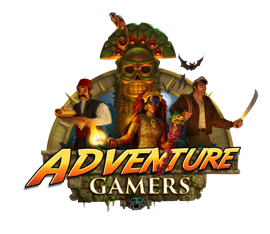Review for 3 Minutes to Midnight
With its striking 2D cartoon-style art and zany humor, this quintessential point-and-click adventure could comfortably sit alongside golden-era LucasArts titles without looking out of place. Some players have called it the best adventure since Return to Monkey Island. So, how well does 3 Minutes to Midnight recapture that sense of magic – and, crucially, how does it differentiate itself from such beloved and established sources of inspiration?
The game opens in 1940s New Mexico with a bang – quite literally – when an explosion erupts near a strange desert town, wiping the inhabitants’ memories. Plucky teenager Betty awakens with no idea where or who she is. As she sets about finding out, however, she soon discovers that there’s much more to this mystery than her unconventional hometown – including a doomsday plot counting down to eradicate everyone’s existence.
One of the main ways the game sets itself apart from classic adventure titles is in its approach to puzzle-solving. While puzzles follow familiar adventure game mechanics involving environmental exploration and inventory item combinations, they can be solved in various ways. This means different playthroughs could potentially look radically different, and items, characters and settings could take on brand new significance in different contexts.
My main issue with this feature, however, is that it can only fully be appreciated by players who invest time into replaying the game. And, as I simply played the game once in the way that appeared most logical to me, it didn’t necessarily feel so different from playing an adventure game with set solutions.
Even had I played a second time, I wouldn’t necessarily know how to tackle puzzles any differently. In other narrative-driven games, on the other hand, such as Telltale games, critical choices are clearly signposted, so exploring different avenues would be a simple matter of selecting different options; here, however, much more digging would be needed. While this might appeal to players with the requisite time and interest, they would need to be careful not to lock themselves out of certain outcomes, which I found could be easily done by something as simple as making a seemingly innocuous dialogue selection. Sometimes this meant that items I’d built up and a certain path I’d been following were rendered suddenly redundant because of a misstep; the game offers you alternative ways of going about things, of course, but this can be initially jarring.
Puzzles are otherwise well-balanced, creative and enjoyable; 3 Minutes to Midnight tends not to overload you with too many items at a time, so the adventure game liability of mindlessly mashing together item combinations is largely avoided here. The interface is intuitive, and I appreciated the variety of puzzles, too, keeping things fresh; some required speaking to other characters, others needed observation and careful timing, and some called on your own knowledge of the game.
There are an impressive number of environments, with new scenes for every chapter. Many of these are panoramic, and all are beautifully lit and detailed, which is unsurprising given that the environment artist, David Puerta, has worked on such titles as Runaway and Broken Sword. Locations are bursting with quirky, distinct characters brought to life by a strong voice cast and feel visually integrated into backgrounds, with expressive faces and animated movements. They do have a somewhat marionette-like quality, but this is perhaps suited to the overall cartoony style, reminiscent of the Monkey Island 2: LeChuck's Revenge remake.
The expansiveness of the environments (and multiple potential puzzle strands) was a stumbling block for me, though, on the few occasions when I got stuck. This was sometimes due to an illogical puzzle solution or simply because of a lack of direction; I might have known what my eventual goal was, but I didn’t always know how to go about achieving it. For these instances, a more comprehensive hint system or checkable objective list would have been helpful; while characters gave repeatable instructions, there was no way of tracking progress on these. Prompts are sometimes given, signaling the next course of action, but there were moments when I found myself circling the environments repeatedly after exhausting every dialogue option with no further direction.
The main issue that affected pacing most critically, however, was the overlong, excessively intricate dialogue trees. The game boasts the largest script in point-and-click history; the positive, though overenthusiastic, intention here seems to have been to provide fleshed-out character backstories and world-building. The effect, though, is unfortunately disruptive; much of the dialogue describes extraneous characters and events that you are told about rather than shown, making it difficult to care much about them. Otherwise, jokes are hammered into the ground. There were times where I spent long stretches doing the conversational rounds without apparently progressing or solving any puzzles; some characters seemed to serve no other purpose than to distract.
Thankfully, the developers listened to feedback about this aspect and have since updated the game with the option to highlight game-progressing dialogue, enabling you to skip non-essential options. As soon as this was provided, I took full advantage of it, which is a shame; much effort has clearly gone into the writing, but it would benefit from being more interwoven with events of significance to the active plot and gameplay and being edited down significantly.
The game’s humor, a key characteristic, fell into a similar pitfall for me; every line felt like a joke, giving it a try-hard quality. And, being admittedly subjective, this might have been less tiresome had I simply found it funnier. While there are certainly clever moments, the humor relies quite heavily on fourth wall breaking, pop culture references (including memes) and – at least regarding the larger-than-life (and consequently grating) protagonist, Betty – childish, exaggerated responses that sometimes involve drawn-out, unskippable scenes.
An extension of the different approaches to puzzles and dialogue options is the possibility of multiple endings, encouraging replayability. Progress can be monitored via a tracker, a winding Jumanji-esque board of branching paths representing four unique conclusions. Throughout the adventure, the tracker showed me that I was following a single narrative path. By the end of Chapter 4, however (and after around 22 hours of gameplay), a chance decision diverted my path into another – decidedly undesirable – ending, cutting my game short by a chapter and barring me from the story’s culmination.
Not ideal, I thought, but surely I can just backtrack to the point where I messed up and try a different tack. Only, while the tracker suggested where the split had roughly occurred, it didn’t let me return to it, and I couldn’t be sure exactly where I’d gone wrong. Auto-save points failed me here, too. Possibly there was no single condemning point but a series of decisions that had culminated in my dissatisfactory ending. Left with the choice of replaying the (surprisingly lengthy) game from scratch with no real idea of what to do differently or living with the consequences of my blunder, I chose the latter. Until this point the plot had been building towards a grand reveal, and, having played as Betty and her mother separately, I was intrigued to see how the different parts of the narrative would coalesce, so this was frustrating – but I simply couldn’t justify the additional investment required.
3 Minutes to Midnight has many strengths: high production values evident in its impressive visual and sound design and a vivid, whimsical world and characters. Sadly, while the game clearly demonstrates the developers’ passion for the genre, it expects a corresponding level of commitment from players, which doesn’t always make for an entertaining experience. Its overcommitment to dialogue and relentlessly wacky brand of humor might appeal to some but otherwise proves that you can indeed have too much of a good thing, and the ambitious features that set it apart from other games of its type – multiple paths and endings – work against it in the end.
WHERE CAN I DOWNLOAD 3 Minutes to Midnight
3 Minutes to Midnight is available at:
We get a small commission from any game you buy through these links (except Steam).Our Verdict:
3 Minutes to Midnight’s high production values and vibrant, idiosyncratic world recall the best of classic adventures, but it often goes overboard and requires a steep level of commitment from players to get the most from it, dampening the fun factor.




























